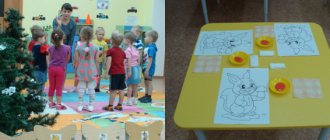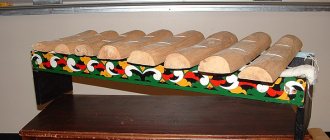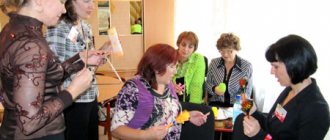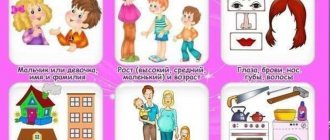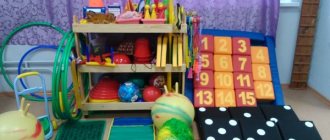Teaching children to play children's musical instruments. - presentation
Teaching children to play children's musical instruments
Lesson plan: 1. The meaning of playing musical instruments. 2. Classification of musical instruments, selection requirements. 3. Organization of a children's orchestra. 4. Methods of teaching children to play musical instruments.
1. The importance of playing musical instruments In the process of learning to play the MI: a new world of sound colors opens up before children, an interest in instrumental music appears; A new world of sound colors opens up before children and an interest in instrumental music appears; musical notation is being mastered and children's active vocabulary is being enriched; musical notation is being mastered and children's active vocabulary is being enriched; children master skills of varying degrees of complexity - from involuntary waving, tapping with rattles to playing the melodies of familiar songs with memorizing the location of sounds on the keys and strings; children master skills of varying degrees of complexity - from involuntary waving, tapping with rattles to playing the melodies of familiar songs with memorizing the location of sounds on the keys and strings; mental processes, musical abilities, and volitional qualities of the individual develop; mental processes, musical abilities, and volitional qualities of the individual develop; Playing MI can be used in classes with a teacher and in independent activities that arise on the initiative of children. Thus, playing MI has an impact on the comprehensive development of the individual and has great educational and educational significance.
2. Classification of DMI, selection requirements. Music pedagogy has long been involved in the issues of children's music playing. The merit of Carl Orff, an Austrian composer and teacher, who took part in the construction of special instruments for children (“Orff instruments”), is especially great in this area. Modern preschool educational institutions rely on centuries of experience in using voiced toys, common among the people, in raising children. The most ancient of them appeared in the 1st-2nd centuries. They are rattles and rattles made of wood and drilled bones. Later, metal toys appeared. During excavations in ancient Russian cities, clay whistles in the shape of a goat, rooster, dog, duck, etc. were found. Over time, two types of musical toys - instruments - unvoiced and voiced were established.
“Musical toys” and “children’s musical instruments” Unvoiced Voiced Unvoiced Voiced -representing instruments - reduced, simplified copies intended for real instruments, similar to creating a playful situation with them in appearance and method in which children produce sound. They are divided into 4 types, fantasizing and singing, depending on the nature of their sound. playing on MI. 1. AI with sound of unfixed height 1. AI with sound of unfixed height (rattles, tambourines, drums, castanets); (rattles, tambourines, drums, castanets); 2. AIs built on one sound - pipes, 2. AIs built on one sound - pipes, pipes, horns; pipes, horns; 3. AI with a given melody (automatic toys) 3. AI with a given melody (automatic toys) – music boxes, drawers; – music boxes, boxes; 4. AI with diatonic and chromatic 4. AI with diatonic and chromatic scale – metallophone, piano, flute, scale – metallophone, piano, flute, saxophone, button accordion, harmonica, balalaika). saxophone, button accordion, harmonica, balalaika).
Classification of musical toys and instruments N.A. Vetlugina 1. Group of strings dulcimer harp balalaika gusli domra On stringed musical instruments, sound is produced by touching the strings with your fingers or a pick (a thin plastic plate).
2. Wind group saxophone melodic flute clarinet Sound on wind musical instruments is produced by blowing air into the instrument's tube, and sometimes by inhaling it from the tube. triol
3. Group of percussion keyboards Piano grand piano
4. Group of keyboard-reed button accordion accordion harmonica
5. A group of percussion instruments having the xylophone metallophone scale. The sound on percussion instruments is produced by striking the sounding body of the instrument with sticks or by hand. develops basic musical abilities: modal sense, musical-auditory perception and sense of rhythm.
5. A group of drums that do not have a scale drum tambourine cymbals castanes maracas rattles triangle bells develops a sense of rhythm and expands timbre concepts
Each of the above instruments has a unique timbre, source of sound production and method of sound production. For example, a metallophone has a light, ringing, silver timbre; The sound is formed as a result of vibrations of metal plates and is extracted by striking a hammer. To be used in preschool educational institutions, musical toys and instruments must meet the following requirements: be well tuned; be well disposed; have a certain clear timbre; have a certain clear timbre; be child-friendly in terms of size and weight; be child-friendly in terms of size and weight; have a simple design; have a simple design; be durable, suitable for frequent use in everyday life. be durable, suitable for frequent use in everyday life.
3. Organization of a children's orchestra. Children's orchestra is one of the types of collective music playing (O.P. Radynova). In the 20s of the XX century. The first to raise the issue of teaching children to play simple musical instruments was the famous musical figure and teacher Nikolai Afanasyevich Metlov. He also came up with the idea of organizing a children's orchestra. In the 30s The first children's orchestra (noise) appeared. It consisted of the simplest percussion instruments: bells, rattles, castanets, tambourines, drums and other instruments. This orchestra allowed children to fulfill one of their most cherished desires - “to play music.” Soon mixed children's orchestras appeared, consisting of instruments on which a melody could be played. The first was a wooden xylophone, and then: metallophone, zithers, children's pianos and role, accordion, triplet, clarinet, harmonica, spoons, triangle and wind harmonica. Gradually, new types of children's musical toys and instruments came into use at preschool educational institutions. ON THE. Metlov did a lot of work to create and improve the design of the DMI.
In his publications N.A. Metlov gives detailed methodological recommendations on the use and configuration of instruments, the sequence of teaching children to play the MI, a description of the techniques of playing each of them, and gives examples of ready-made instrumentation for a children's orchestra. Together with Nikolai Afanasyevich Metlov in famous teachers T.S. worked Babajan, Yu.A. Dvoskina, Maria Aleksandrovna Rumer and others. Subsequently, N.A. was involved in the development of these questions of methodology. Vetlugina and her students (K. Lyankevichus, V.V. Ishchuk). Radynova Olga Petrovna, Katinene Albina Ionovna, Palavandishvili Marine Levanovna distinguish the types of children's orchestra: noise ensemble mixed orchestra - percussion consisting of including instruments from the same different groups not having or the same type of instruments Sound of instruments
The noise orchestra is the simplest and most accessible. It can be organized with younger children if they can rhythmically reproduce strong beats by clapping. A rattle, a box and others are used. It is important to select timbres that expressively emphasize the character of the music. The sound of the orchestra will be more varied and interesting if the instruments play not only together, but also alternately, combining with each other. Before performing the piece, it is necessary to discuss with the children what instruments will be needed for the game.
One of the types of noise orchestra is the Ensemble of Spoonmen (middle and senior groups). It sometimes includes several other instruments: To organize a wind instrument ensemble, it is necessary that each child has his own instrument. If children are musically advanced, an ensemble can be organized by the end of the senior year. No more than 10 children are invited to play in an ensemble. To avoid monotony of sound, all members of the ensemble should not start playing at the same time. It is preferable if with each new verse the number of instruments that come into play increases. You should first play at a slow tempo, and then in accordance with the character and means of expressiveness of the work.
The forms of work of a music director in teaching children to play the MI are different: individual training, lessons with an ensemble, with an orchestra. Education in the middle group begins in the second half of the year, with the metallophone. Individual training is much easier to carry out. It is prescribed in the morning, before breakfast or in the afternoon, lasts 5-7 minutes. Before creating a mixed orchestra, as a rule, ensembles of instruments with a scale (metallophone) are organized. Classes with an ensemble and orchestra are held in the preparatory group, with various musical instruments, at the request of the child; in the afternoon once a week, lasting a few minutes. Classes on learning to play individually and in an ensemble consist of two parts: 1st part – learning the melody of a piece under the guidance of an adult; Part 2 – work on old, familiar material with tempo, dynamics, and expressiveness of performance. Before starting training at the DMI, it is necessary to introduce children to them - look at them, name them, listen to how familiar melodies sound on them.
Mixed orchestra Ensemble playing requires coherence in performance. This concerns rhythm and overall musical expressiveness. The teacher encourages children to listen to their playing and the playing of their partners, listen to the piano part, not try to drown out each other, and try to convey the moods expressed in the music.
The main requirement for playing in an orchestra is that all instruments are tuned to the same tone. The initially performed piece should be played separately with each child, and then in parts. The most appropriate composition of the orchestra: Children's piano - 2 Accordion -2 Accordion -1 Metallophone -6 Triol -2 Pipes -2 Triangle - 1 Cymbals - 1 Drum - 1 Tambourine - 1
Options for the arrangement of instruments in the orchestra Option 1. Zither zither zither zither zither zither zither zither zither zither zither zither
Option 2. Zithers zithers zithers zithers zithers zithers zithers zithers
When choosing a repertoire you should: - choose simple melodies that are familiar to children; — take into account the structure of the melody (sounds should be located close to each other). For example, “In the garden or in the vegetable garden.” — take into account the structure of the melody (sounds should be located close to each other). For example, “In the garden or in the vegetable garden.” Directions for teaching children to play in an orchestra: 1. Learning a piece of music and playing instruments under the guidance of a teacher. 2. Independent selection of familiar pieces of music by ear. 3. Composing music for children to perform on musical instruments (simple songs to a given text, marches, lullabies, dance songs).
4. Methods of teaching children to play musical instruments. Objectives of learning to play musical instruments: 1. Play simple melodies individually and in an ensemble. 2. Know the names of instruments, recognize their timbre. 3. Master the techniques of playing the metallophone, and, if desired, other instruments; use your breath correctly when playing triplets, clarinets, and pipes; find a convenient fingering when playing the accordion and button accordion. Piano; muffle the sound of cymbals and triangles; hold your hands correctly when playing the tambourine, drum, shaking castanets, maracas. 4. Play in an ensemble, observing the general dynamics, tempo, entering and ending in a timely manner. 5. Select well-known songs, jokes, and rhymes by ear. 6. Improvise simple songs.
Stages of learning to play the MI: 1 – listening, memorizing the melody, singing. 1 – listening, memorizing the melody, singing. 2 - selection of melody (singing). 2 - selection of melody (singing). 3 – performance of the song. 3 – performance of the song. Learning to play the MI begins with a group of percussion instruments that do not have a scale. Classes are conducted with small groups of children and individually. It is advisable to use musical instruments in everyday life in order to consolidate the sense of rhythm of music that appears in children. In 2 ml.g. children can already play a tambourine, wooden spoons, cubes, rattles, musical hammers, drums, bells; get acquainted with the metallophone. In Wed. For the first time, they begin to teach children to play MIs that have a scale. The most convenient for this is a metallophone. Training can be carried out by notes, by color or digital designations, by ear. In the color system, each sound and its corresponding key (or metallophone plate) are assigned a specific color designation. Having a record of the melody in a color designation, the child presses that key or hits the plate with a hammer that corresponds to the color indicating a particular note.
This approach to playing musical instruments continues in the digital system, in which each sound and its corresponding key (or plate) of the musical instrument are designated by numbers. For example, the note “C” is number 1, the note “D” is number 2, etc. The digital system, justified and introduced into the practice of primary music education by the French teacher E.I. Schewe (1804 - 1864), was widely used in preschool education in the second half of the 19th - early 20th centuries in Russia. It was used in their teaching activities by Vladimir Fedorovich Odoevsky, Sergei Irineevich Miropolsky, Lev Nikolaevich Tolstoy, Boleslav Leopoldovich Yavorsky, and later Nikolai Afanasyevich Metlov. Boleslav L. Ya. ( )
Both systems (both color and digital) are convenient in the initial musical education of children, as they allow you to easily and quickly obtain the desired result when teaching children to play the MI. The disadvantage of these systems is associated with the predominance of mechanical reproduction of melodies on an instrument without relying on the child’s musical and auditory ideas. This disadvantage is overcome by teaching children to play musical instruments by ear. From the very beginning of classes, the child develops the skill of elementary auditory orientation in a melody in the process of identifying its pitch orientation. From the first lessons, the teacher teaches the child to listen attentively to the melodic line and reproduce it on the instrument expressively and intonationally. The child learns the rhythm of the melody by ear, without counting. The child hums a melody (with words, either on the syllables “li”, “la”, or with his mouth closed - on the consonant “m”), tries to remember and find individual sounds on the instrument. In older groups, children learn to play melodic instruments - strings, wind instruments, keyboards and reeds.
The musical lessons with peasant children of Leo Tolstoy at the Yasnaya Polyana school are extremely instructive and revealing. Today this may seem incomprehensible in music lessons, even in Moscow schools. He writes: “In the first lesson, I divided everyone into three voices and we sang the following chords: We succeeded very soon. And everyone sang what he wanted, tried the treble and moved to tenor, and from tenor to alto - so that the best (students) learned the whole chord - C - E - G, some of them all three. We sang these chords at school, and in the yard, and in the garden, and on the way home until late at night, and could not tear ourselves away and rejoice at our success” (emphasis added by me - L.V.). Further, Tolstoy gives advice on how to easily master singing from notes, and claims that this is necessary and accessible to ordinary peasant children. Lev Nikolaevich pays special attention to singing from notes based on relative solmization*. Solmization (solfeggio) is a method of singing a melody from notes with syllabic names of steps (do, re, mi, fa, etc.) and reading the melody when playing an instrument using the letters of the Latin alphabet (CDEFGABC). *
Teaching preschoolers to play from notes should be based on the gradual mastery of the connections between the individual links of the “see-hear-play” complex. First, the “hear – see” connection is worked out, i.e. melodies that are familiar to the ear are shown to the child in musical notation. Then the same connection is mastered in the reverse order: “I see - I hear,” i.e. visual perception of the musical notation of a familiar melody instantly turns into hearing it. The establishment of the first two connections gradually prepares for the perception and reproduction of the entire necessary “see-hear-play” complex. Thus, the teacher’s goal when teaching a child to play musical instruments is not for the child to master as much musical material as possible, but to interest the child in music with the greatest intensity.
She taught me a lot. For the first time, it seems, I understood a very important truth: children are able to perceive, remember and even reproduce quite complex music, provided that the music is bright, imaginative and natural in its development. If there is no brightness, imagery and naturalness in it, children will never perceive or remember even the simplest music, because it will not touch either their hearts or their consciousness. Dmitry Borisovich Kabalevsky Dmitry Borisovich Kabalevsky
